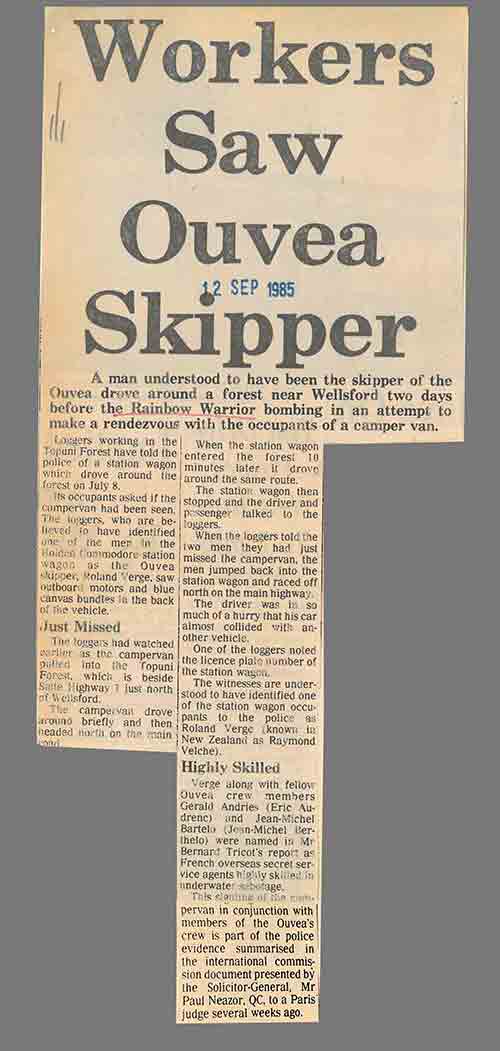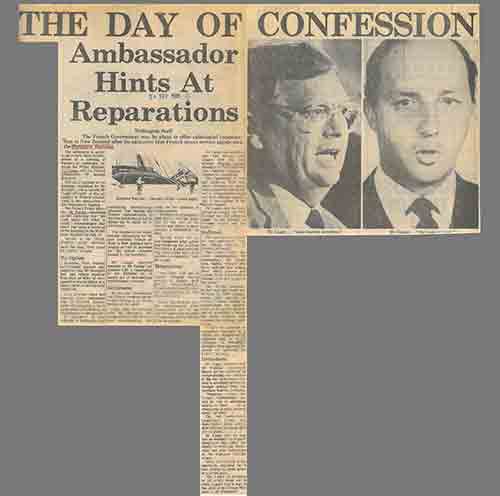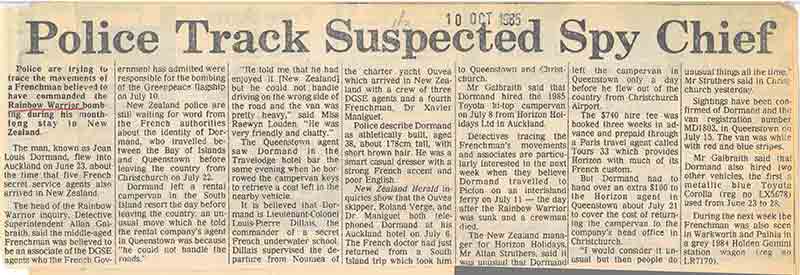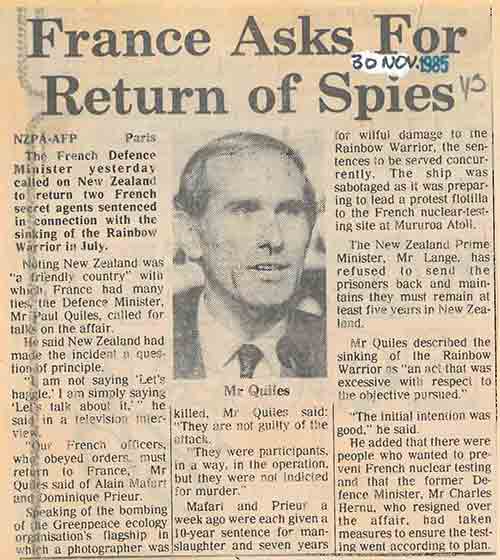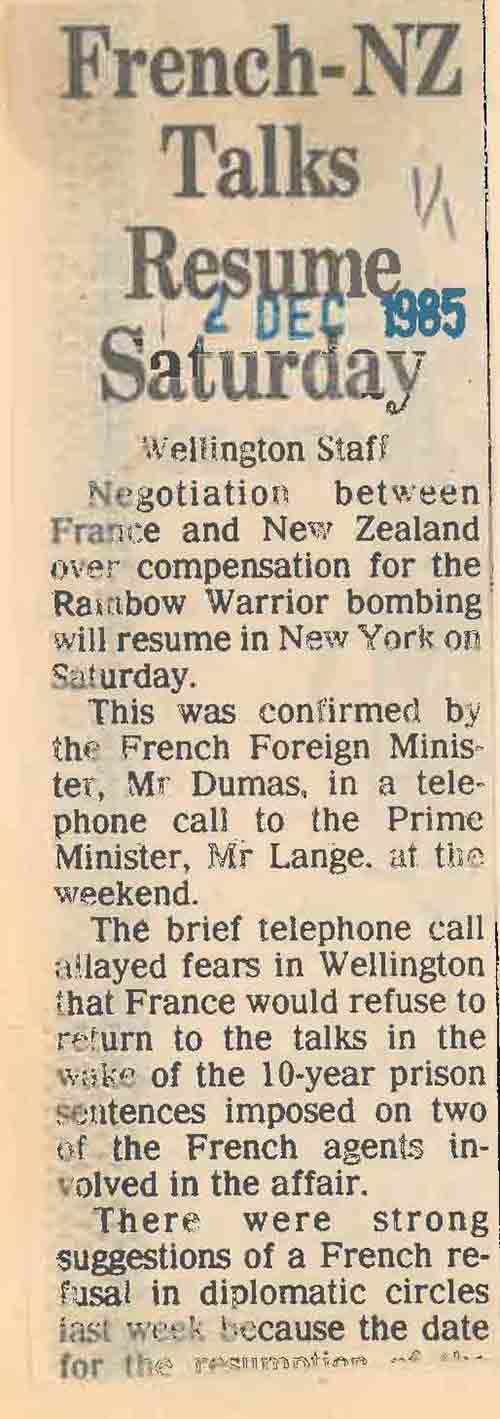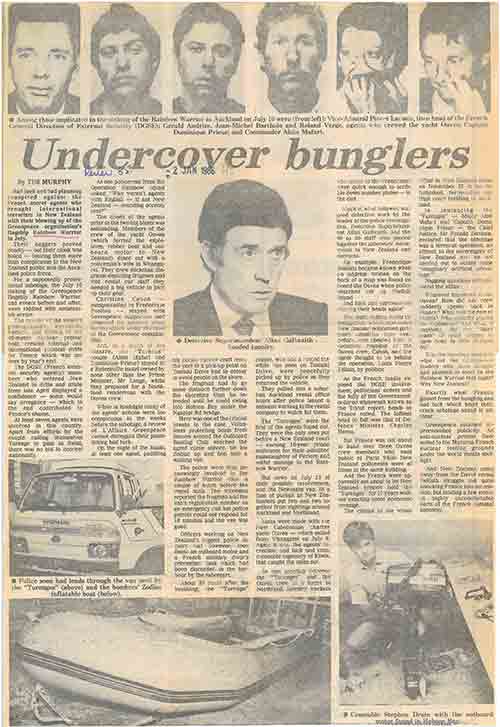Behind every daring spy is a miserly bean-counter demanding a receipt. That may be the single most significant factor in the French government being exposed as the perpetrator of one of the most outrageous acts of terrorism on a friendly country.
Waiting for a modest refund led to the capture of two of the dozen or more saboteurs who came to New Zealand and in turn the unmasking of the French government operation to sink the Rainbow Warrior.
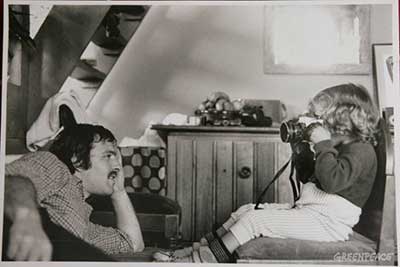
(source: Greenpeace)
Just before midnight on July 10, 1985, two bombs ripped gaping holes in the Greenpeace flagship that was to lead a flotilla to Moruroa atoll to protest against French nuclear testing. The Rainbow Warrior sank in four minutes. Portuguese-born crew member, Fernando Pereira, drowned after going to his cabin to retrieve his camera gear.
By morning it was known that the source of the explosions came from outside of the hull, enabling investigation head, Detective Superintendent Allan Galbraith to comment, “it is possibly murder and possibly terrorism.”
In the following days, leads flooded in. Four Frenchmen, claiming to be on a winter yachting holiday in Northland, made themselves conspicuous almost everywhere they went. An abandoned French-made inflatable was located shortly before the explosions and an outboard motor soon after. The driver of the inflatable was reported getting into a campervan on Tamaki Drive a few hours before the bombs went off. Alert citizens noted the number plate.
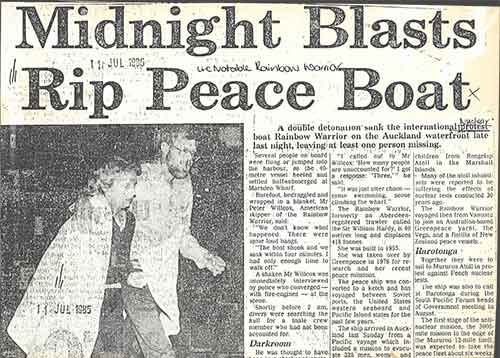
Detectives caught up with Alain Mafart and Dominique Prieur on the morning of July 12 as they waited at rental firm Newman’s for a refund of about $130 for the early return of the camper van used to support the bombers.
Newman’s staff delayed them long enough for detectives to arrive. “That was 100 per cent crucial,” says Maurice Whitham, who was second-in-command of the police investigation. “Newman’s did a really good job. They could have walked out. They could have just left the campervan on the side of the road, got on the flight and they would have been gone.”
Mafart and Prieur, posing as Swiss honeymooners Alain and Sophie Turenge, had their tickets to freedom, having changed their flight to 11am that day – 36 hours after the explosions. They could have used the Swiss passports they flew in on as police had yet to discover they were fake, that Mafart was using the identity of a dead man.
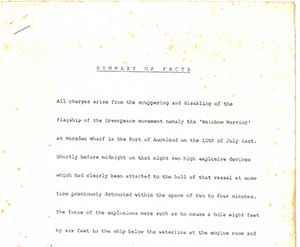
According to the police statement of facts tabled in court, they were in Hamilton the day before from where they telephoned their DGSE contact in Paris in a panic. Police traced the number to the French defence ministry.
The accountants at the DGSE – the French Secret Service – may have been right never to trust their spies. Another team of agents used a yacht, the Ouvéa, to bring in the explosives, the Zodiac inflatable dinghy and specialist combat diving gear that did not leave tell-tale bubble trails. When New Zealand police caught up with the crew in Norfolk Island five days after the bombing, a search of the boat turned up a receipt from the Dome Valley tearooms, north of Auckland. It had been doctored – the amount changed from $8.50 to $58.50.
What resonated for Kiwis about the bombing, aside from the breathtaking gall of a supposedly friendly nation, was how it exposed the hubris of the French who thought the mission would be a doddle in a backwater such as New Zealand. The mission to disable the ship was achieved but a catalogue of errors ensured lasting embarrassment for the French.
In the New Zealand of 30 years ago, foreign accents were novel and the unusual was noted.
It is an insular country, distant, withdrawn, which does not think for a second that it will get caught up in the turbulence of the world
From the nosey, blunt, scout, Christine Cabon who posed as scientist Frederique Bonlieu to infiltrate Greenpeace’s Auckland office, to the yacht Ouvea almost running aground with its clandestine cargo upon landfall on the perilous sandbar of the Far North’s Parengarenga Harbour, to the crew’s sexual escapades (including bedding a policeman’s wife), to their suspicious behaviour at an attempted rendezvous with Mafart and Prieur in a Northland forest that prompted a logging contractor to note down their car registration, to mis-judging the tides, to Mafart and Prieur waiting for a refund, the DGSE’s plan unravelled speedily and profoundly.
Mafart blamed politicians. The mission, he wrote in his book, The Secret Diaries of a Combat Diver, was ill-conceived, executed in haste and based on a dismal ignorance of New Zealand, “a little Switzerland of the Pacific”.
“It is an insular country, distant, withdrawn, which does not think for a second that it will get caught up in the turbulence of the world,” Mafart wrote. “We did not know that in this country you cannot make a move without being observed, that informing the police is a national duty.”
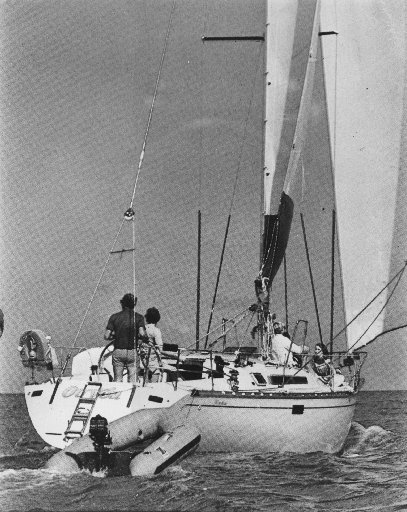
Mafart claimed Defence Minister Charles Hernu rejected a more discreet, low-key operation based on many months of reconnaissance in favour of a quick and grand action. Operation Satanique was launched in April and the attack scheduled for mid-July.
The DGSE preferred to blame amateurish behaviour of some of the saboteurs. They “trailed clues behind them like Hansel [in the fairytale Hansel and Gretel]”, lamented Alain Chouet, a senior DGSE official at the time.
The chain of events that led detectives to Mafart and Prieur may have begun with a decision to plant the bombs earlier than planned.
A Frenchman by the name of Francois Regis Verlet, claiming to be a Greenpeace supporter went on board the ship on the evening of the bombing. Though Verlet’s clean-cut appearance and ignorance of French peace groups struck some of the crew as odd, he learned that a skipper’s meeting was imminent and would be followed by a birthday party for one of the crew
According to a plausible narrative, the agents changed plan to place the bombs hours later and instead attached them to the hull about 8.30pm to take advantage of the skipper’s meeting which meant crew would be pre-occupied. They supposedly set them to go off during the party. The French have claimed this was to guard against loss of life because the party was on the relative safety of the upper deck. However, many in the peace movement see this as propaganda and point to factors such as that no warning was given, the blasts were at night and the bombs were of a size to rapidly sink the ship as indications the intention was to kill in order to strike fear into the hearts of all crews of vessels planning to go to Moruroa.
Said Greenpeace New Zealand’s recently retired executive director Bunny McDiarmid, who was on the ship earlier on the day of the explosions, said: “No one will believe that a bomb placed on the side of our ship, in the middle of a cold winter night, whilst most people were sleeping on board was a warning. The bomb blew a hole the size of a truck at our waterline and sunk the Warrior in four minutes. A bomb is not a warning.
“The French agents were certainly incompetent but the suggestion that the first bomb was supposed to be a warning is cowardly and insulting and doesn't change the fact that they remain guilty of murder.”
After the bombs were placed, the Zodiac made its way to a ramp by Teal Park on Tamaki Drive to find the tide too low to get the dinghy and motor out of the water, a consequence of the changed plan. By now the frogmen who placed the bombs had disappeared into the night and the inflatable, helmed by one man, headed towards Okahu Bay looking for an easier landing place along the waterfront, with the Turenges trying to track it in their campervan.
According to French media reports, the driver was Gérard Royal, brother of Segolene, the current number three in the French government and the Socialist Party candidate in the 2007 presidential election.
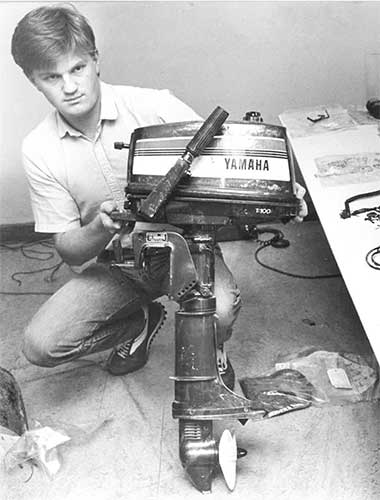
outboard motor
The dinghy and its driver were seen by two fishermen and a cyclist on his way under Ngapipi Road bridge and into Hobson Bay. One reported hearing a splash under the bridge from where an outboard motor was later recovered. Next, men on neighbourhood watch duties at the Auckland Boating Club in Hobson Bay saw a dinghy being pulled from the water. They watched as bags from the dinghy were loaded by two men into a campervan.
Convinced they were watching the aftermath of a burglary, the boating club members noted the camper’s registration number, LB8945, and phoned the police.
The campervan was long gone by the time police arrived. It was noted that the serial number was missing from the French-made Zodiac.
Next morning at the first Auckland CIB briefing about the bombing, Verlet’s name was mentioned as a possible suspect. He’d left on a flight to Tahiti shortly before the explosions. Sometime during the day the report about the strange rendezvous of the dinghy and the campervan was followed up, even though the sighting was nearly three hours before the bombs went off.
Rebecca Hayter and her flatmates returned from the movies 23 hours after the explosions to find the message light flashing on the new answerphone bought by a flatmate for his freelance photography business. It was from a colleague from Newmans rentals asking her to ring urgently, the police were at the office asking about the Turenges. Hayter, now editor of Boating New Zealand, had been working for the company for just a few months while she took a break after university and contemplated a career in journalism. The couple were neat and tidy, she told police. He was friendly, she wasn’t.
Hayter had met them on July 8, two days before the bombing, when they came in having broken the windscreen. “The only thing that was a tiny bit odd was his insistence on staying with the van,” Hayter told the Herald. When she offered to help transfer their gear into the replacement campervan, Mafart was polite but firm. “No thanks”.
Hayter didn’t make the connection to the sinking of the protest ship downtown but arrived at work in Mt Wellington next morning curious about the foreign couple. “I nearly blew it,” she recalls. “I walked in and said [to another staff member] do you remember those people, the Turenges?' She said, ‘That's them there'.”

Mafart and Prieur had come in to drop off the campervan, having moved their flight forward to later that morning. They had been scheduled to leave in in Wellington a week later.
What happened next handed detectives their first big break. Hayter and other staff called the police and concocted a ruse of a refund to delay the pair. They would have to wait for a manager to arrive to sign the cheque, the Turenges were told.
Detectives had found their car blocked in the Auckland Central station carpark and lost time before commandeering the boss’s car. For Hayter, it seemed to take an age for them to arrive.
Meanwhile, management types (suits and briefcases) arrived and disappeared into offices. The Turenges became edgy. Hayter looked up from a back office to see Mafart staring intensely “and not in a friendly way” through a glass strip in the door. “At some level he knew,” she said. “We pretended to be adding up dates and times, but I bet in the months to come he thought, ‘boy, I should have listened to my instincts’.”
A plainclothes detective arrived, approached the counter and quietly asked the receptionist, who had just arrived at work and was ignorant of what was playing out, where the pair were. Hayter quickly approached and whispered, “right behind you”.
Mafart remained calm and polite when approached by the police officers and after some discussion he and Prieur agreed to go to the station with police. Had they known that the law at the time did not allow police to hold suspects on suspicion of terrorism, they could have insisted on catching their flight which was departing in a few hours.
The pair were held from 9am until midnight. In breaks from questioning, a French-speaking policeman sat with them in a room reading a newspaper. Mafart would reassure Prieur that they would get through this. “Remember the mountain,” he would say. The next day, police followed as they booked new flights at a Queen St travel agency.
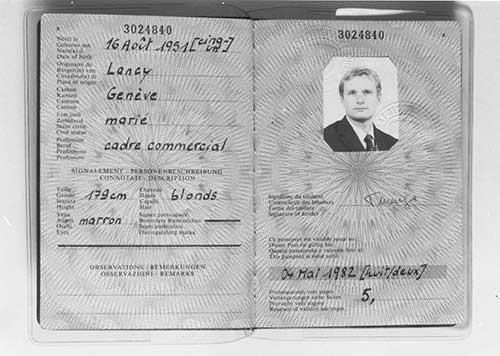

Alain and Sophie Turenge
By July 15 police had confirmed their Swiss documents were fake. The pair were arrested for making false immigration declarations. That served as a charge to hold them on. By the end of the month they had been charged with murder, conspiring to commit arson and wilfully damaging the Rainbow Warrior.
When police searched the Ouvea after it arrived at Norfolk Island on July 13, they discovered what would become evidence of the crew's involvement in the plot. As well as traces of explosives, Mafart’s fingerprint was found on a Newman’s map. That gave the lie to Mafart’s claim that they had never met the Ouvea crew.
Among other documents was a Greenpeace brochure with a Grey Lynn address scribbled on it. The address led to a Greenpeace member and in turn to the discovery of the scouting role played by Christine Cabon.
Local law gave the detectives just 24 hours before they had to let the three crew leave (a fourth, Dr Xavier Maniguet, had left for Sydney before the detectives arrived), far too little time for the evidence to be processed. The Ouvea was allowed to sail for its stated destination of Noumea. It never arrived. The yacht is believed to have been scuttled and the crew picked up by a French Navy vessel.
But France’s secret mission was sunk too, the links that emerged between the agents and to Paris meant France could no longer deny involvement. Heads began to role up the ranks. Two months after the bombing, Defence Minister Charles Hernu fell on his sword. A week later it was the turn of his spy chief, Admiral Pierre Lacoste.
In November, Mafart and Prieur pleaded guilty to reduced charges of manslaughter and wilful damage and were sentenced to 10 year jail terms by chief justice Sir Ronald Davison. “People who come to this country and commit terrorist activities cannot expect to have a short holiday at the expense of our Government and return home heroes,” the judge said.
Butter, lamb and politics trumped justice, and they returned as heroes to France inside three years. Most of their time served was spent in comfort on Hao atoll, in French Polynesia, to where Prieur’s husband, Joel Prieur, was appointed head of security. She became pregnant. The new French defence minister welcomed Prieur as she stepped off the plane in France, while Mafart received promotions and was decorated by Paris.
Eleven years after the bombing, France ended its nuclear tests in Polynesia following further protests by Greenpeace and Pacific interests.

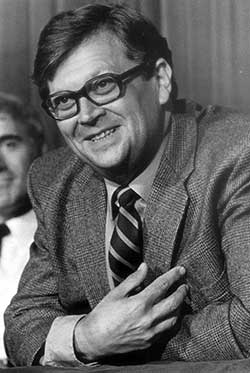
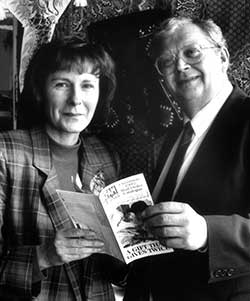


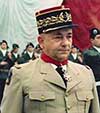
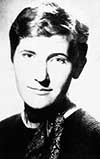
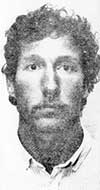
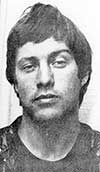
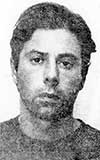

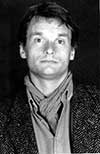




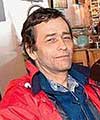
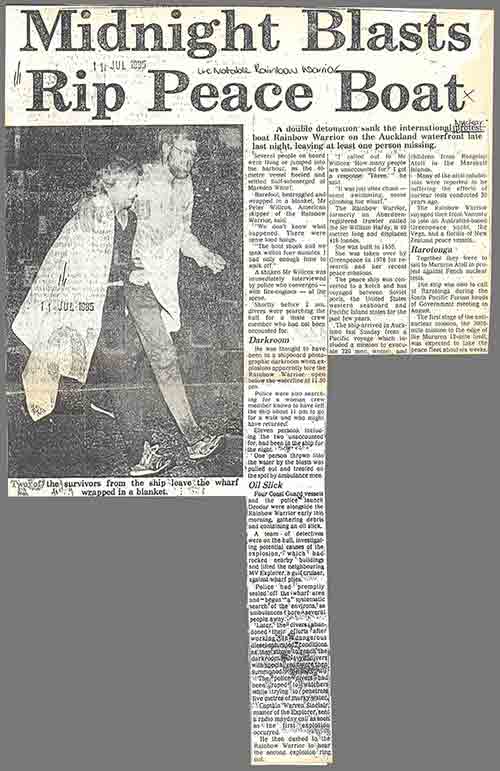

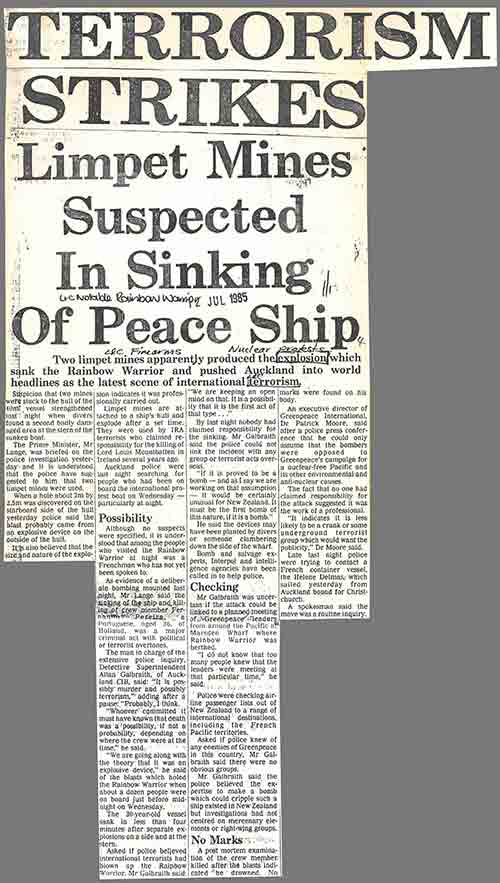
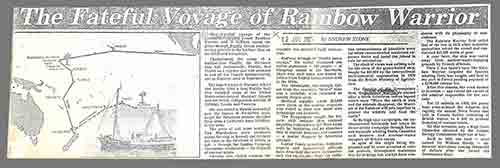


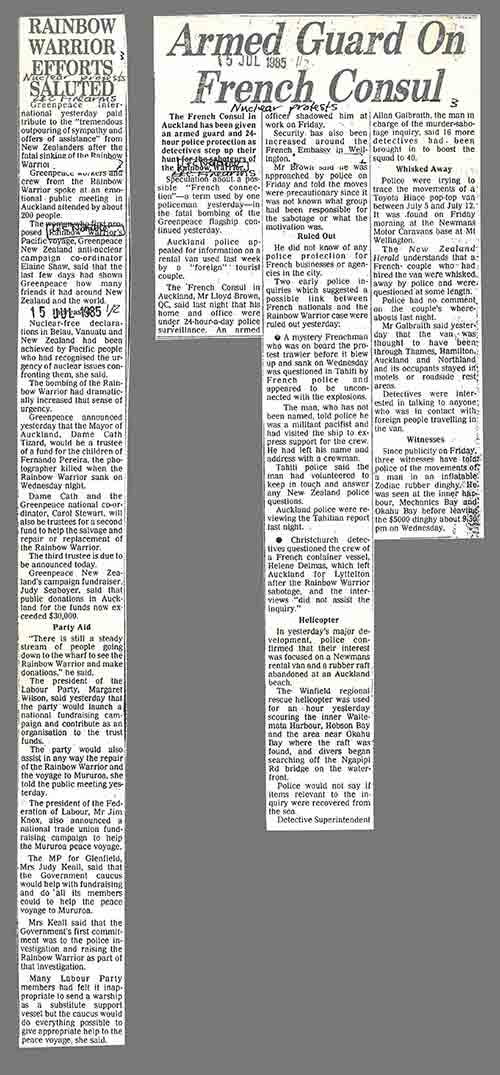
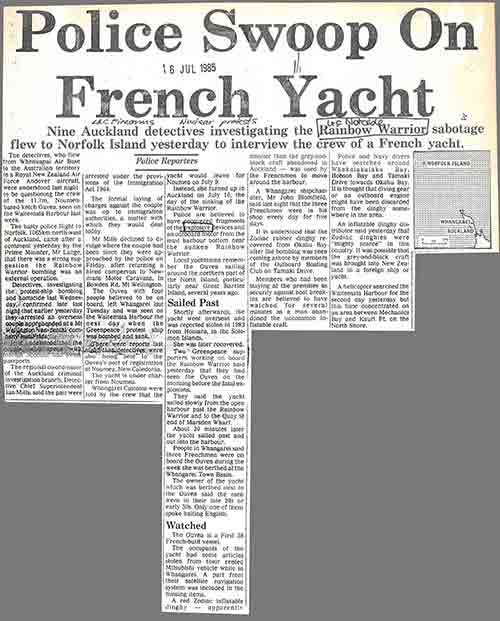
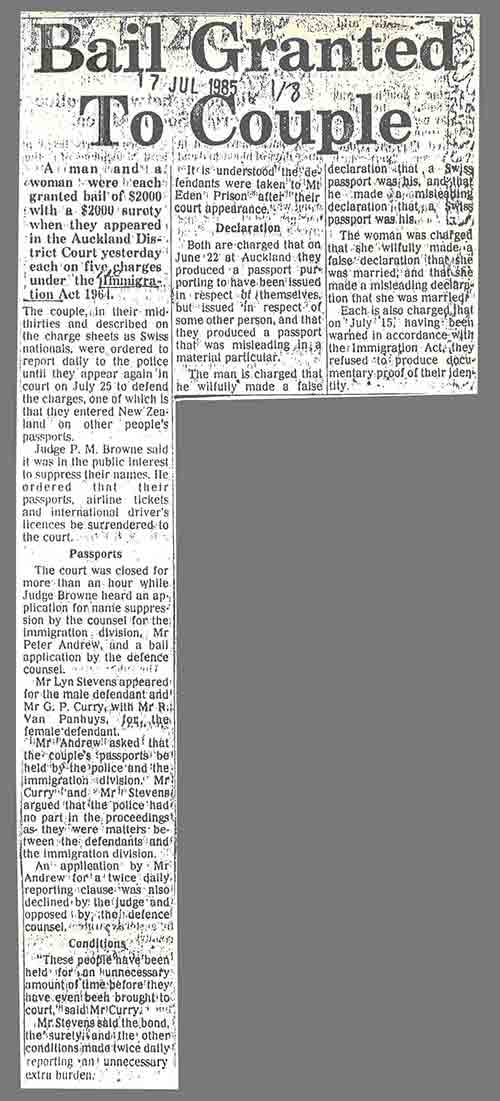


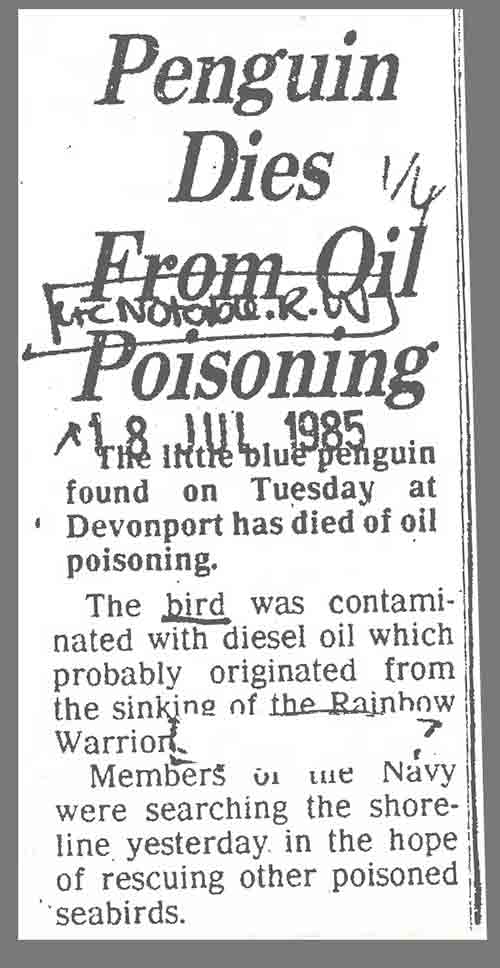
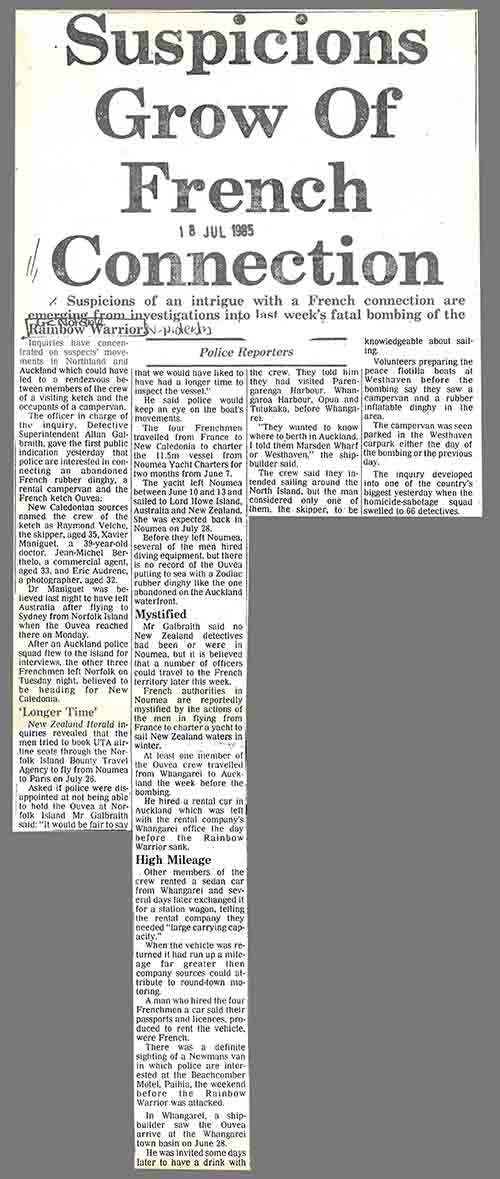

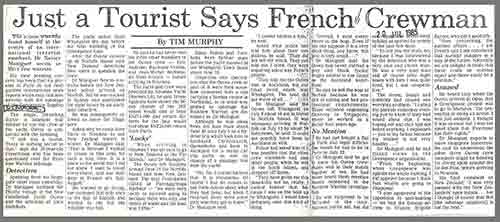
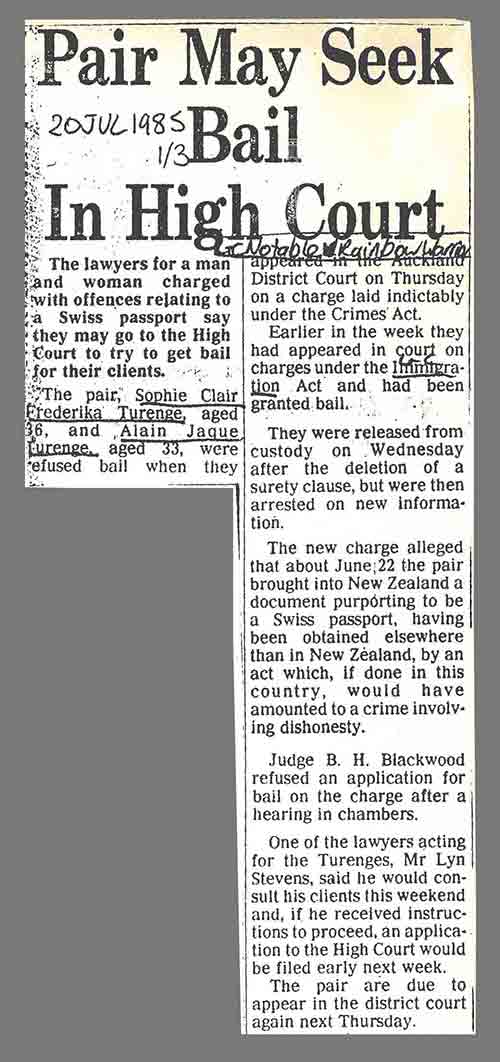

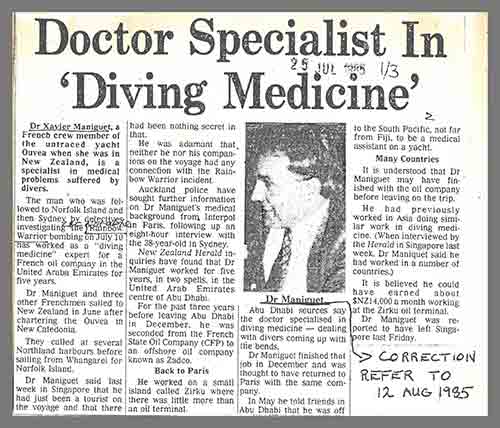
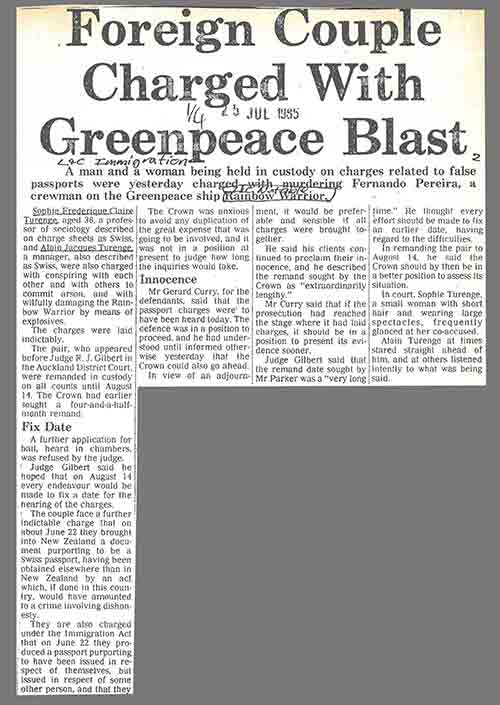
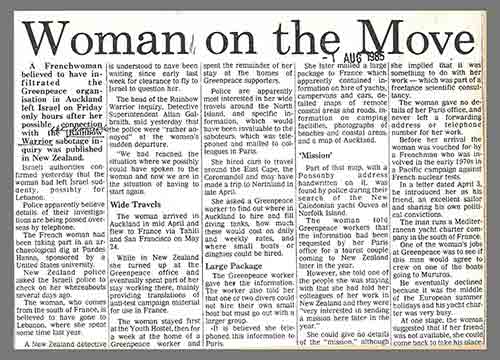
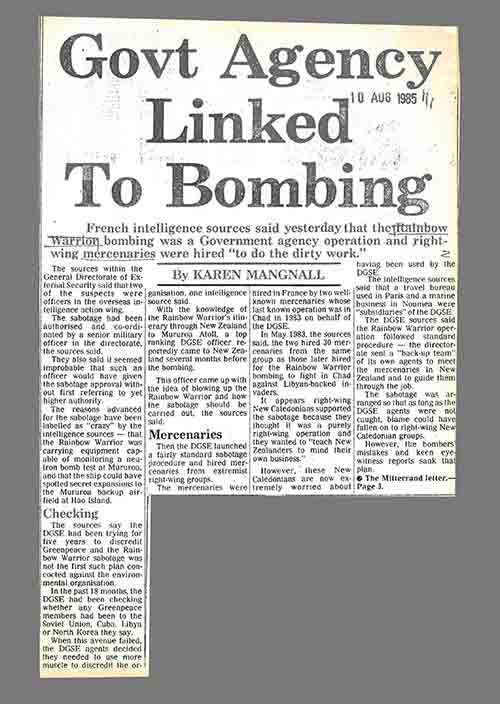
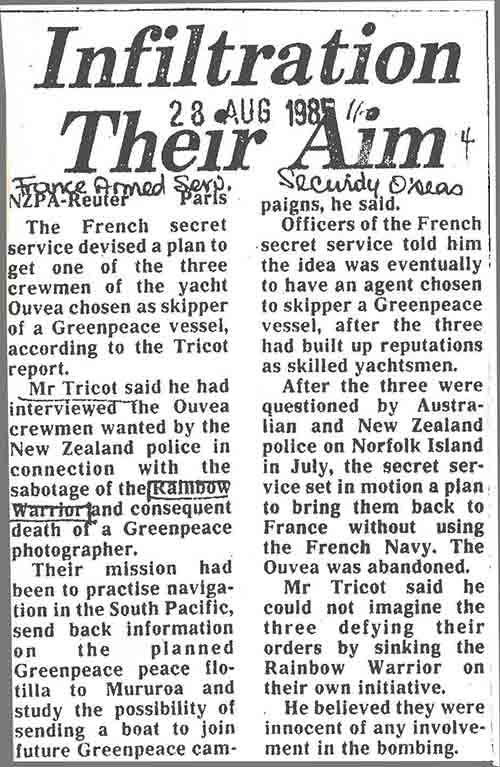
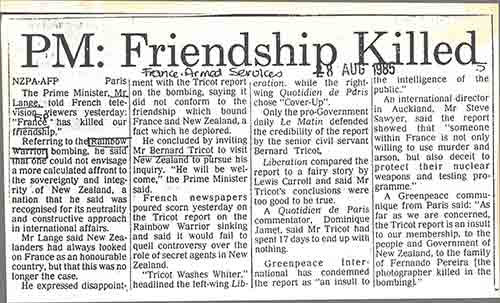


.jpg)


